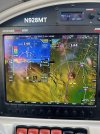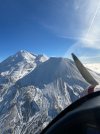I've been out of the loop on avionics for years now. I used to work on B-52 bomber aircraft avionics many years ago. I wanted to know how you guys/gals feel about advanced avionics vs. conventional. Do you think using conventional makes the pilot more proficient at the world around him and doing the old fashioned paper computations using pilotage and dead reckoning? Or is the use of GPS so wide-spread now that it's literally a requirement? Is it much easier to navigate if you had an all-in-one instrument device that gave all calculations digitally? Or is the pilot crippled by using modern avionics?
I used to fly B-52’s and B-1’s years ago. I’ve been flying since 1976. I’ve witnessed the steady march of technological advancement over the years.
Growing up with very basic instruments and learning and using all those new technologies as they were introduced has given me
a perspective that might not be popular with “push button pilots”, but that’s ok.
It‘s my considered professional opinion that while many of those new, advanced avionics and autopilots make life considerably easier for all of us as pilots, far too many younger (by experience level) pilots rely completely upon those technologies. As a direct result, Situational Awareness is sorely lacking in the generations of pilots who grew up using
only modern, high tech avionics.
I do not have a sheaf of empirical studies proving this. However, anecdotally, I started to see the differences between old and new in the B-1 before I got out of the Air Force After 12 years. Different outlooks, different attitudes, different priorities in the cockpit. In
many cases, these differences in experience and basic knowledge base caused a noticeably diminished SA.
Twenty-six years flying Part 121 (and GA as well) after the Air Force did not change what I saw, day-in and day-out. In fact, over those years, I noticed that even many “old timers” became dependant upon the complex avionics and especially, the wonderfully capable, integrated autopilots. The Faa’s max use of automation push accelerated the loss of basic skills.
It’s easy to lose basic hand flying and finger counting skills if you use profile mode coupled to the autopilot from climb out to DH. Again, anecdotally, I saw this while instructing and evaluating in the military and in 121 operations. It’s also easy to lose that feel for the aircraft that tells you what you can and can’t do with your aircraft, and what you should or shouldn’t try. I urged my students to ”use the force” as much as possible. Some did, some clearly thought I was crazy. Oh well.
I freely admit that I am an anachronism, a dinosaur. I hand flew the airplane whenever it was legal to do so. Whether the jet or the simulator, I hand flew without auto throttles whenever I could. i used all those wonderful modern systems when they were necessary, but I never used them as a “crutch” because it would make the line check easier.
In a perfect world, every new pilot would learn to fly in a basic airplane with basic instrumentation to learn those basic skills necessary for good situational awareness. The romance with fancy displays and autopilots that far outstrip the less experienced pilots
abilities would come later.
Somehow, I really don’t see that happening. But it would make things a lot easier when that MFD goes out in the weather or the autopilot won’t engage and the weather is well below forecast. But those things could never happen.
Right?


